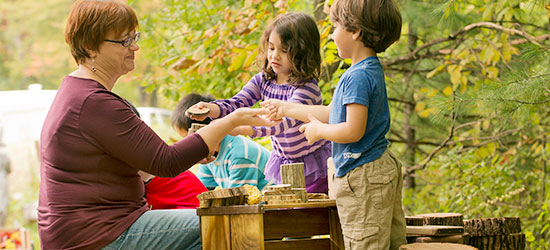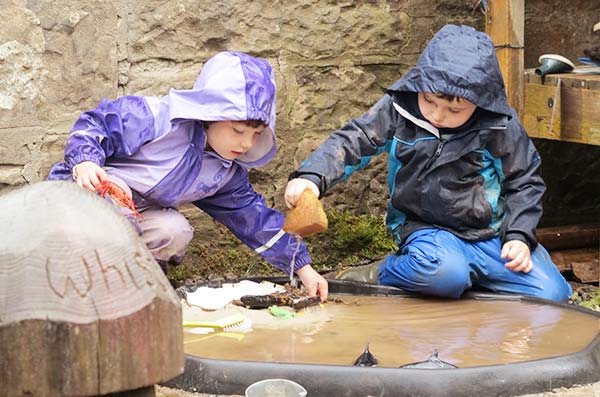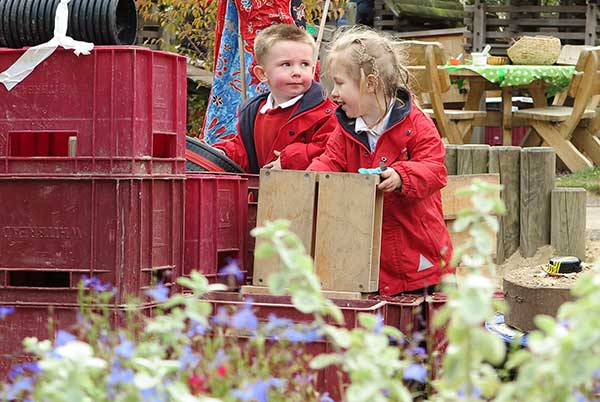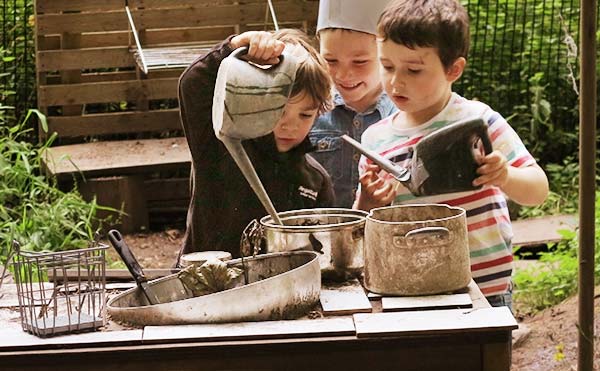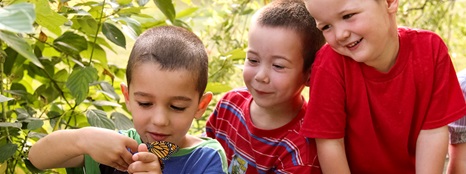Laying the groundwork for life:
Creating nature experiences for children
| March 2017By most standards it was a grey and dismal day. Last night’s snow was melting as temperatures rose fast – creating muddy pools and dripping gutters. The playground was half frozen mulch, half icy depressions. Most schools would keep their students inside. However, instead of painting or snuggling up to read books, Bija students were dressed in waterproof boots, hats, and jackets. Many were squealing with utter excitement as they jumped again and again in puddles so large that their jeans were dripping with mud. Others were filling pots and pans with mulch, ice, and rocks in our “mud kitchen” and still more were exploring for roots and worms in the partially frozen raised bed gardens. For Bija children, it was a beautiful day.
A platform for learning
When I started working as an educator 15 years ago, creating nature experiences for children was far from my mind. I was always invested in creative, open-ended, play-based education because I understood this as the basis for meaningful learning. Yet the more I think about ways to support children in growing into productive, happy, and kind individuals, the more I realise that time outdoors may be the missing ingredient. Spending unstructured time in nature opens a world of wonder and awe. There are ample opportunities for discovery. Nature experiences, whether in the schoolyard, at a nearby park, or on a camping trip can help kids understand the interconnectedness of our beautiful earth. Outdoor experiences shouldn’t just be reserved for after school hours or weekends with parents. Time in nature is not a luxury; it’s a platform for educating children.
Beauty in nature is diverse and multifaceted. It often takes multiple experiences in the same place, and in various types of weather, to understand just how wonderful the outdoors can be. Left to roam freely outdoors, most kids quickly dive in and begin to notice patterns, create forts, tree houses, or play imaginative games together. They let go of their fears of being dirty and “doing it right” and instead, embrace uncertainty and change. For some this shift is immediate, and for others it may take more time. In general, kids long to climb trees or spend focused minutes observing the amazing things happening an inch below the earth. These desires help the wind and cold melt away on less than perfect days. Children’s literature, toys, and materials are covered with depictions of animals and plants. Often a baby’s earliest sounds are the “bah bah” of a sheep or the “tweet tweet” of a bird. But what about actual experiences in nature? How many kids feel the icy breeze on their face or navigate a forest trail regularly? How many schools opt to turn off the video in the auditorium and send kids out to recess in the snow and rain?
Longer school days, more homework, urbanisation, organised sports, and daily access to technology all play a role in children spending less time in nature than ever before. Studies show that children now spend 90% of their leisure time inside and many schools contribute to this trend. We don’t place the proper value on time outside, time without intentional goals or structured expectations. This is robbing our kids of joy and challenge – both such meaningful parts of life.
The benefits of nature
What happens when kids have unstructured time to play and explore outdoors?
Problem Solving
Unlike a structured school day, the routine of home life, organised classes, and sports, there is no telling what one will encounter outside. Whether it is crossing a stream, building a fort, or figuring out how to scale a rock, time in nature helps kids figure stuff out. When kids learn to problem solve in situations that are fun and spontaneous they are able to carry those skills into their schoolwork and daily life.
Risk Taking
Kids need to learn to take risks in order to be able to cope with the world. Life is full of adversity and many children today do not have the skills to manage everyday challenges. Playing outside requires kids to try things that might scare them, but does so in a way that is fun and inviting. How exciting was it the first time you climbed a tree, figured out how to trap minnows, or encountered a wild animal? These situations build self-esteem and foster a willingness to try new things.
Increased Creativity
Children who play outside become naturally curious and creative. Nature is full of open-ended materials. Pine cones become babies, leaves become blankets, and sticks become telescopes. Using imagination and creativity are valuable skills that will guide kids throughout their life.
Physical Development
It’s important for children to use their bodies in experimental ways. Outdoor play in nature inspires and often requires running, kicking, jumping, climbing, and balancing. Coordination and core strength are improved as a result of these activities. When these skills are fostered early on, children are more successful not only in sports, but in academics as well, not to mention they are healthier in mind and spirit.
Reduced Mental Health Issues
Studies show that anxiety, depression, and possibly even ADD are reduced when children spend more time in nature. Children today have less control over their lives than ever before. Since 1955 the school day and school year have continued to get longer and homework has become the norm (sometimes for kids as young as 3!). The more scheduled we make their lives, the more children suffer from depression, anxiety, and attention deficit challenges. Children need freedom to play. They need time to themselves and with peers. It is no surprise that as we have removed these things from kid's lives we have seen a vast increase in psychological problems. Time in nature offers great opportunities to help kids regain some control of their childhood.
Learn Empathy
When children understand the sanctity of life they respect it. Time in nature helps kids understand just how precious life is, and that life truly is all around us. Our world is in crisis and our children are the generation that will be able to stand up and fix it. Appreciating nature is the first step in the process.
The role of the teacher
Where and how do I begin?
Offering children nature experiences doesn’t have to be overwhelming. Teachers can find ways to incorporate nature into everyday activities.
- Bring natural materials into the classroom. Use shells, rocks, seeds, beans, and tree slices for counting, sorting, and dramatic play activities.
- Add fresh or dried flowers to the centre of your classroom tables. Herbs such as lavender and rosemary also make excellent natural centrepieces. Have children collect wildflowers on a nature walk and display them around the classroom. A beautiful classroom space enhances learning experiences.
- Use time outdoors as a “listening experience”. Before heading out of the classroom let students know that you will use your ears to “hear nature”. Discuss what sounds you might hear – birds, crickets, the crunching of leaves underfoot. When you return to the classroom, process what you heard in a discussion or through art-making. Create a classroom book with drawings or photographs of the “sounds of nature” in your local environment.
- Plant something. Even if you don’t have access to your own outdoor space, there are ways to grow things with children. Plant a small herb garden in the classroom window, start some sunflower seeds to take home in plastic baggies, or grow a pot of lettuces to use to create a salad together. If you are really inspired, join a community garden! An added bonus is that kids are more likely to try new foods when they participated in caring of the plants.
- Skip the playground and explore an open green space, a grove of trees, or a hiking trail. Bring a bird book and learn some of the native birds. Take photographs of trees and plants and research their names when you return to school. Modelling an interest in the natural world will help students express their own excitements and discoveries.
- Make art with natural materials. Start by giving students collection bags on a nature walk. This could simply be a walk around your school building or around the block. Resist your desire to limit what children can put in the bag as long as it is natural, safe, and can fit inside. Children are born explorers and you will be amazed what they notice and collect! When you return to school, allow everyone time to observe their own and others findings. Materials can be collaged onto butcher paper or pieces of card stock or cardboard.
Finding joy in nature
Spending time in nature doesn’t have to be perfect. It may require examining your own assumptions about teaching and your relationship to the great outdoors. Children will watch what you model and notice if bugs, dirt, cold temperatures, or bright sun make you embrace the outdoors or stay inside. What are you interested in exploring? What are your children excited about? Start with the things that move you, collect reference books from the library and bring nature back into the classroom. Each little step will help create connections. This is the real work, the real learning. Finding meaning and joy sets the stage for a lifelong desire to grow, question, and create change. When students become invested, mindful people – and I believe nature experiences lay the groundwork for just that – then we as educators can be proud.

